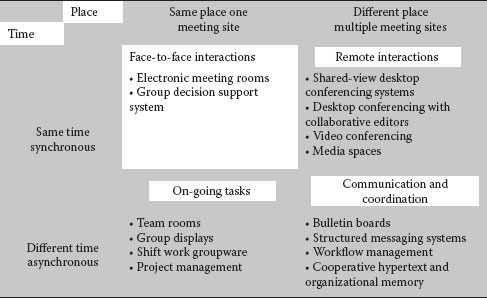Characteristics and Elements of Global Virtual Teams
Decades ago, teams relied on videoconferencing for meetings; nowadays, new collaborative communication technologies such as Trello, Skype, Google+, Zoom, and others have transformed the way people work at a distance. Moreover, the spread of social network tools like Facebook, WhatsApp, Twitter, and MySpace has made it much easier for teams to develop a relationship despite the lack of opportunities to meet physically. Thus, the effective management of globally distributed teams includes managing their virtual collaboration; this has become even more crucial as multinational corporations (MNCs) increase their reliance on the ability to transcend barriers of culture, distance, and time. In such a situation, culture does matter in the form of intercultural communication styles and the cultural values to which team members subscribe.
In global virtual teams (GVTs), although barriers such as time and space are reduced, communication barriers can be greater because of cultural differences. Not only are people geographically dispersed; they are also functionally diverse and bring in various areas of expertise, unique knowledge, and specialized skills (Morley et al. 2015). For example, a team composed of people from Malaysia, Canada, the United States, Britain, Germany, Japan, and France is more socially, culturally, and linguistically complex than a team composed of people from New York, Nebraska, Massachusetts, and California. The larger the cultural distance between GVT members, the greater the challenge of working together. Even for members that come from nearby geographical regions, for Eastern countries, the Japanese style of working is different from that of people from Thailand. The German negotiating style is different from the British. Hence, it is both demanding and complex to manage at a cultural level, but it is a necessity when GVT members may come from opposite ends of the world.
Given the two dimensions of time and space, studies in computer-supported cooperative work (CSCW) have developed a matrix illustrating the possible combinations (see Figure 3.1) and the possible working methods (Kirkman & Mathieu 2005; Johansen 1988). The two time dimensions are (1) synchronous—real-time communication that occurs at the same time and (2) asynchronous—communication occurs at different times (for example, I email you a question, and, a few hours later, you reply). The two place dimensions are (1) same—people meet in the same room, face to face and (2) different—people meet virtually while geographically distributed in multiple locations.
People in GVTs normally work autonomously and have inner-directed motivations. Yet they are also interdependent, need trust and commitment from others in the group, and share power and leadership based on individual members’ technical and knowledge expertise. Members are bound by a common purpose, cooperative goals, and concrete measures of project effectiveness and the need to manage and coordinate their collaboration. These joint concerns become the basis for developing communication processes and norms, common rules for interacting, and a distinctive manner of thinking and behaving. The characteristics of a GVT can be divided into four aspects, each of which needs to be considered by MNCs when they embark on using this novel work structure.
Figure 3.1 The time and space dimension for CSCW. (Adapted from Johansen R., Groupware: Computer Support for Business Teams, New York, The Free Press, 1988.)
Culturally Distinctive, Culturally Synergistic
GVTs are composed of culturally heterogeneous members. MNCs can no longer expect that their teams will contain only people of the same cultural orientations. Many local or regional companies, in an effort to cut their operating costs, initially introduced virtual teams to bring together people from different branches of the same organization. For example, marketing teams from different cities could communicate without the need to travel for a face-to-face meeting. For MNCs, it is a different case. Their teams are normally composed of members from all across their international operations. Thus, managing an MNC team’s cultural complexity is very different from managing a team that is composed of members who are culturally homogeneous. The distinctive characteristics of the GVT depend largely on their mind-sets, emotions, and actions, which are all manifested in their cultural values and their cultural roots. However, the more distinctive are their cultures, the more synergy the members bring to the teamwork.
Working Together, Working at a Distance
GVT members will be working together apart in a geographically disperse environment. They will have few or no opportunities to meet their colleagues who may be thousands of miles away. They will rely heavily on computer-mediated communication (CMC) technologies, as well as social network systems. The biggest challenge of working in this environment is that members will need to learn to understand each other without any historical experience of each other’s capability or past performance. Working together not only brings huge benefits such as the generation of ideas, the creation of innovative strategies, and strong collaboration, but it also builds skills in working together at a distance. Such work arrangements, without people meeting face to face, are no longer impossible. GVTs are a powerful strategy for recruiting the best human capital and leveraging their highest potential.
Technology Dependent, Technology Savvy
GVT members will rely heavily on CMC for their collaboration. Companies must therefore train their employees to be competent in using such technologies and to feel comfortable operating in a virtual environment. Technology continues to advance rapidly and exponentially, and GVT members need to keep abreast of new developments. Not only do they need to be competent culturally; they also need to be proficient technologically. It may be challenging to determine which and what types of software and technological applications to use. Team members can identify their preferences, but cultural values will influence such preferences. For example, Easterners who value nonverbal cues in their communication may prefer to use videoconferencing or Skype because, that way, they can see their colleagues’ facial expressions when communicating. On the other hand, for Westerners, visual aspects of communication are secondary; they prefer to evaluate the explicit content of what other members communicate. They rely heavily on the textual content of conversations, rather than using emoticons (e.g., smiley faces), to convey their feelings or to infer the feelings of others.
Different Times, Different Urgency
Members will be operating in different time zones. This means that they need to align schedules in two or more countries when they plan their meetings. For example, when members from Singapore and America are working together, they need to accommodate the fact that they are 12 hours apart. The time dimension also has an underlying cultural aspect in that people view flexibility versus urgency differently. How and what people perceive about time, such as the degree of urgency to complete a task within a deadline, may vary based on culture. For example, some team members might need hours of deliberation and to weigh their options before finalizing a decision due to their habit of working in a hierarchical system, whereas, in other cultures, people can quickly make decisions because they feel empowered to do so, and they are held accountable for the decisions.
In conclusion, it is time for MNCs to engage in expert change management, strategic planning, global human resources management, and technology management in order to deploy GVTs in the most efficient and effective manner. Not only do these teams need to be trained in using various forms of collaborative technological tools; they also need to be prepared to cope with cultural diversity. On the one hand, technological tools can make high-performing teams more efficient and effective. On the other hand, it is more important to ensure that members are well coordinated in their assigned tasks, as well as compatible in their working styles, so that the challenges of working together at a distance can be minimized. In short, GVT collaboration not only requires people to work together but also demands the management of the participants’ interdependent relationships as they work on common tasks, thus contributing toward common goals.
Case 3: Cultural Vignette
The Virtual Workplace: Working with Strangers in Cyberspace
In his inaugural meeting as a newly appointed CEO of Hewlett-Packard Tokyo, Mr. Bryan John announced that all managerial level executives would participate in global virtual teams effective next quarter—that is, next month. “We need to find ways to reduce our large operating costs,” he explained. “One major expense is overseas assignments, which has both tangible costs such as travel and sending executives abroad as expatriates, and intangible costs such as the difficulty of adjusting to new cultures. Global virtual teams will enable us to work together at a distance, without leaving our home offices. With the sophisticated technology available today, I am confident that everyone is capable of working in this innovative teamwork structure.” Following his announcement, he heard nothing: no cheers, no applause, and no salutes. Instead, he saw anxious, solemn, and grim faces across the room. There were a few minutes of total silence. He noticed some managers staring blankly at their colleagues, while others looked down with unhappy faces. Bryan was puzzled and surprised at receiving such a response. He had thought people would be delighted upon receiving such news, that they would be happy they would not need to go to the United States given the long and tiring hours of travel, and not forgetting the potentially painful adjustment period. In the corner, Mr. Namura Misoto tried to envision such a work platform and make sense of his manager’s decision. Many questions rushed to his mind. He became anxious at the idea of facing such a drastic change. The good part, he thought, was that he wouldn’t have to think about relocating. His unpleasant experience years ago as an expatriate in New York still haunted him. However, a lot of questions troubled his mind. “What is virtual teamwork? With whom will I work with—will they be strangers? How can I trust them? How will I communicate with them?” He thought about the normal greeting customs: bowing to a colleague when they met, offering courteous conversation, and only gradually engaging in discussion of work. Such customs were so ingrained in him that he feared it would be difficult to establish rapport with new team members if he could not observe their gestures, hear their tone of voice, and come to understand their way of working. He was also well aware of the direct style Americans were known for, and it intimidated him. In the virtual workspace, how could he deal with working with strangers in the absence of the many nonverbal cues he was accustomed to rely on? He felt that the change toward a global virtual team’s structure was coming too soon; they needed a longer time to adjust. Silently, he opposed the decision. “I know my people, I know the Japanese way of working! We need cultural and technological training, so they will feel competent and confident. Technology is certainly prevalent in our workplace, but dealing with human behavior, especially when combined with cultural intricacies, is a serious challenge. Time is essential.”
Johansen, R. 1988. Groupware: Computer Support for Business Teams. New York: The Free Press.
Kirkman, B.L. & Mathieu, J.E. 2005. The dimensions and antecedents of team virtuality. Journal of Management, 31(5), 700–718.
Morley, S., Cormican, K. & Folan, P. 2015. An analysis of virtual team characteristics: A model for virtual project managers. Journal of Technology Management & Innovation, 10(1), 188–203.

